
The genetic basis of coat colour in the Labrador Retriever has been found to depend on several distinct genes. The interplay among these genes is used as an example of epistasis.

The genetic basis of coat colour in the Labrador Retriever has been found to depend on several distinct genes. The interplay among these genes is used as an example of epistasis.
Labrador Retrievers are a popular dog breed in many countries. There are three recognised colours, black, chocolate, and yellow, [1] that result from the interplay among genes that direct production and expression of two pigments, eumelanin (brown or black pigment) and pheomelanin (yellow to red pigment), in the fur and skin of the dog. The recognized colours are due to two genes, while a third gene affects the range of colouration observed within the yellow Labrador. These individual genes do not act independently of each other, and their interaction in affecting the trait of coat colour is used by biology textbooks to demonstrate the genetic principle of epistasis, where multiple genes react synergistically to affect a single trait. [2]
The genetics of mammalian colouration has been studied in detail, and similar mechanisms have been identified across many species. For this reason, much of the early work on the colouration of dogs in general and Labradors in particular have relied heavily on analogy to the traits characterized in mice and other mammals. [3] Initial genetic studies of coat colour in dogs published in the 1950s concluded that there were two main genes involved, one distinguishing blacks from browns, and the other distinguishing blacks from reds and yellows. [4] [5] [6] A 1977 study using crosses within a population of purebred Labradors showed the involvement of two specific genes in production of the three main coat colours of Labradors and described the underlying genetics of these colour varieties. [7]
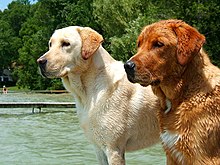
According to Candille, et al. (2007), dog coat color can largely be explained by three genes: MC1R, Agouti and CBD103. When a dog has wild-type alleles at all three genes, it will have a yellow coat. When the dog has a loss-of-function allele at MC1R, it will have a yellow coat regardless of the genes it carries on the other two genes. Only a dominant black allele at CBD103 will produce a black coat color in dogs possessing wild-type alleles at MC1R and Agouti. [8]
The E locus also determines whether the phenotype due to the third genetic locus affecting coat colour will be evident. This locus is recognised as affecting coat colour through the expression of pheomelanin, the pigment responsible for red and yellow pigmentation. The effects on pheomelanin pigmentation are only seen if there is no eumelanin expressed in the fur, else the dark eumelanin will mask any pheomelanin present. Thus these differences are visible only in yellow Labradors, which as a result range in colour from light cream to copper-red.
It had long been thought that the genetic locus for this trait was the same seen regulating pheomelanin in other mammals, subsequently identified as tyrosinase. This enzyme makes both eumelanin and pheomelanin, and when subject to a knockout mutation results in albinism. A less extreme mutation of the same tyrosinase gene, the so-called Chinchilla trait, produces a dilution that selectively affects pheomelanin alone, similar to the phenotype observed in yellow Labradors. [3] Thus, as with Chinchilla-related pheomelanin dilution in other species, this trait in yellow Labradors has been represented by the letter C. However, genetic analysis of the inheritance of coat colour in yellow Labradors has shown that the locus responsible is entirely distinct from the Chinchilla trait of the tyrosinase gene, and likewise is distinct from SLC45A2, [9] the so-called cream gene responsible for the dilution of pheomelanin in buckskin, palomino and cremello horses and also for the absence of pheomelanin in the white tiger, [10] while a mutation in SLC7A11 found to cause pheomelanin dilution in mice was not found in a survey of cream-coloured dogs. [11]
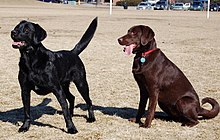
The three recognised colours of Labrador Retrievers result from differences in two genetic loci that affect pigment expression. Those affecting the colour of the dark pigment, eumelanin, are referred to as the B (brown) locus. The variation displayed by this locus is observed in many mammals, reflecting a so-called 'dilution', a lightening, of black eumelanin to a brown colour. Initial genetic research excluded a role for the melanocortin 1 receptor and the Agouti locus as being the cause of the black dilution trait in dogs. [12] Instead, TYRP1 (tyrosinase related protein 1) was found to be responsible. [6] This enzyme is localised to melanosomes, the cellular organelles that produce and store pigments, and serves to catalyze oxidation of eumelanin precursors. [3]
In dogs, three mutations in the TYRP1 gene have been identified, one resulting in a truncation of the protein, the other two leading to an amino acid deletion or a single amino acid substitution in the sequence of the protein. All of these mutations are found across the range of dogs, and hence are thought to have preceded the divergence of distinct breeds, and all three are found within Labrador Retrievers. [6] Each of the mutations appears to eliminate or significantly reduce enzymatic activity, and the colouration phenotypes (the visible traits) produced by the three mutations are indistinguishable. [3]
These represent recessive mutations in the TYRP1 gene, and since mammals have two copies of each gene, one from each parent, an animal with at least one copy of the fully functioning TYRP1 protein (represented as 'B') will display the dominant trait, black pigmentation, while to display brown pigmentation, both copies of this gene must be mutant alleles (collectively represented as 'b'). Thus a dog with the genotypes BB or Bb will express black eumelanin, while brown eumelanin will be seen in dogs with the bb genotype. [1]
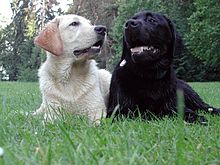
A second gene affects whether these eumelanin pigments will be expressed in the fur or solely in the skin. Called the 'extension' (E) trait, this is directed by the melanocortin 1 receptor (MC1R). This receptor signals the pigment-producing cell in response to melanocortins and results in deposition of eumelanin into the hair. Mutations in this protein have been shown to be involved in pale or red colour phenotypes in a range of species, including humans, horses, pigs, cattle, mice, fur seals, mammoths and the Kermode bear, as well as colouration in whiptail lizards. [13]
In most dogs, activity of MC1R is modulated by two signaling molecules, a repressor that is a product of the Agouti gene (A locus), and an activator, β-Defensin 103 (CBD103), recently named the K locus. In Labradors a highly-active mutated version of the K gene, (KB) is invariant, producing uniform eumelanin distribution independent of the Agouti genotype and leaving differences in MC1R to mediate the sole variability of this signaling pathway. [14] [8] [15]
A recessive mutation in this E gene truncates the protein, producing a non-functional receptor incapable of directing eumelanin deposition in the fur. [16] Among dogs, this mutation is unique to yellow Labrador Retrievers and Golden Retrievers and is thought to have arisen in the retriever population before these individual breeds became distinct. The exact mutation has also been found to underlie the colouration of white coyotes found around Newfoundland, having apparently passed into that population through interbreeding with a Golden Retriever. [17]
A variant of the functional MC1R allele that produces a facial 'mask' in other breeds of dogs (Em) is also present in Labradors, but since the colour of the mask is determined by the B locus, in Labradors the mask this gene produces is indistinguishable from the overall coat colour. [18]
The interplay between these two genes determines the colour of a Labrador Retriever, and is widely used as an example of epistasis. If a dog possesses the dominant phenotype for the extension allele (genotype EE or Ee), then it will display the fur colouration determined by its brown locus genotype, while a dog with the recessive extension trait (ee) will have a yellow coat with either black (BB, Bb) or brown (bb) exposed skin. This results in the three coat colours seen:
These genes assort independently, so a single genetic cross involving two black Labradors each with a recessive allele at both the B and the E locus (BbEe) has the potential of producing all of the possible colour combinations, while crosses involving chocolate dogs can never produce black (there being no dominant B allele in either parent) but can give rise to yellow. Yellow Labradors will breed true with regard to fur colour but those with black skin can potentially produce a Dudley. Dudleys breed true for both fur and skin. The ability of the E locus to override the coat colour directed by the B locus is a classical example of epistasis, where multiple genetic loci affect the same observed trait. [2]
In a study of Labrador retrievers in the United Kingdom, it was found that chocolate labradors had a shorter average lifespan than either black or yellow labradors. They were also found to suffer from more skin and ear disorders. It is unknown whether this is a direct consequence of their melanin genotype, or is due to other recessive genes, amplified through the inbreeding used to propagate the chocolate phenotype. [19]

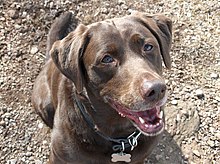
The American Kennel Club (AKC) and other kennel clubs around the world recognize three coat colours in the Labrador: black, yellow and chocolate. [5] In recent years, other colours have become more prominent in the breed through cross breeding with other breeds. Breeders refer to these colours as 'silver', 'charcoal' and 'champagne'. These dogs typically have a metallic-looking sheen to the hair. These are conformation disqualifications within the breed and are linked with a skin disease known as Color Dilution Alopecia. The gene affecting this colour variation in all dog breeds is the recessive 'dilution' (D) locus. It is possible for each of the standard colour genotypes to be diluted if the dog carries two copies of the recessive dilute allele, dd. Dogs that carry at least one D will not have a diluted coat. If two dogs carrying the Dd genotype are bred, diluted offspring could be produced. [20] Studies have linked the diluted trait to a mutation in the melanophilin (MLPH) gene. [21] [22] [23] [24]
The dilution factor was not originally a visible part of the genetics of Labrador Retrievers, and therefore, controversy surrounds the topic. [25] Novel pigmentation can arise through long-masked recessive traits being brought to the fore by inbreeding to select for other traits, through undisclosed outbreeding with other breeds to introduce novel traits, or through spontaneous mutation. There are many breeders in the United States who specialize in breeding these diluted Labradors. The standard for Labrador Retriever does not include dilution colours, and stipulate that any dilute is a breed disqualification, although the American Kennel Club will register purebred Labs that are dilute in colour under the colours of black, yellow or chocolate. [26] The Labrador Retriever Club, Inc. states that there is no silver gene in pure-bred Labrador Retrievers. [27] However, the American Kennel Club has maintained that their registry is based on parentage, not colour.

At least one example of a Labrador Retriever mosaic for pigmentation has been described. [28] This male dog exhibited random but distinct black and yellow patches throughout his coat. He was the result of a black female heterozygous for yellow (B_Ee) bred to a yellow male (B_ee), and was mated with Labradors of each of the recognised colours. The resulting puppies were all consistent with the inheritance pattern of a yellow Labrador with black pigment. The most probable cause was either a somatic mutation early in development or a fusion between two zygotes that left some cells with genetics capable of producing dark fur, and others including the reproductive cells incapable of doing so.
Other "mis-marks" such as brindle, tan points, white spots, and rings around the tails are not uncommon in Labradors. Each of these conditions have various underlying genetic as well as environmental causes.

The Labrador Retriever or simply Labrador is a British breed of retriever gun dog. It was developed in the United Kingdom from St. John's water dogs imported from the colony of Newfoundland, and was named after the Labrador region of that colony. It is among the most commonly kept dogs in several countries, particularly in the European world.
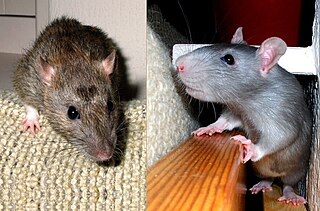
A dilution gene is any one of a number of genes that act to create a lighter coat color in living creatures. There are many examples of such genes:

Cat coat genetics determine the coloration, pattern, length, and texture of feline fur. The variations among cat coats are physical properties and should not be confused with cat breeds. A cat may display the coat of a certain breed without actually being that breed. For example, a Neva Masquerade could wear point coloration, the stereotypical coat of a Siamese.

Bay is a hair coat color of horses, characterized by a reddish-brown or brown body color with a black point coloration on the mane, tail, ear edges, and lower legs. Bay is one of the most common coat colors in many horse breeds.
At right is displayed the color traditionally called liver.
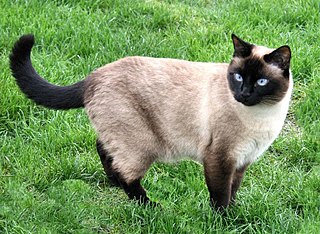
Point coloration is animal coat coloration with a pale body and relatively darker extremities, i.e. the face, ears, feet, tail, and scrotum. It is most recognized as the coloration of Siamese and related breeds of cat, but can be found in dogs, rabbits, rats, sheep, guinea pigs and horses as well.
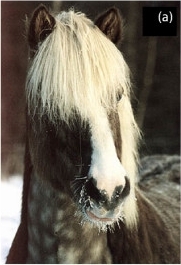
The silver or silver dapple (Z) gene is a dilution gene that affects the black base coat color and is associated with Multiple Congenital Ocular Abnormalities. It will typically dilute a black mane and tail to a silvery gray or flaxen color, and a black body to a chocolaty brown, sometimes with dapples. It is responsible for a group of coat colors in horses called "silver dapple" in the west, or "taffy" in Australia. The most common colors in this category are black silver and bay silver, referring to the respective underlying coat color.

Equine coat color genetics determine a horse's coat color. Many colors are possible, but all variations are produced by changes in only a few genes. Bay is the most common color of horse, followed by black and chestnut. A change at the agouti locus is capable of turning bay to black, while a mutation at the extension locus can turn bay or black to chestnut.

Chestnut is a hair coat color of horses consisting of a reddish-to-brown coat with a mane and tail the same or lighter in color than the coat. Chestnut is characterized by the absolute absence of true black hairs. It is one of the most common horse coat colors, seen in almost every breed of horse.

Agouti-signaling protein is a protein that in humans is encoded by the ASIP gene. It is responsible for the distribution of melanin pigment in mammals. Agouti interacts with the melanocortin 1 receptor to determine whether the melanocyte produces phaeomelanin, or eumelanin. This interaction is responsible for making distinct light and dark bands in the hairs of animals such as the agouti, which the gene is named after. In other species such as horses, agouti signalling is responsible for determining which parts of the body will be red or black. Mice with wildtype agouti will be grey-brown, with each hair being partly yellow and partly black. Loss of function mutations in mice and other species cause black fur coloration, while mutations causing expression throughout the whole body in mice cause yellow fur and obesity.

Horses exhibit a diverse array of coat colors and distinctive markings. A specialized vocabulary has evolved to describe them.

Amelanism is a pigmentation abnormality characterized by the lack of pigments called melanins, commonly associated with a genetic loss of tyrosinase function. Amelanism can affect fish, amphibians, reptiles, birds, and mammals including humans. The appearance of an amelanistic animal depends on the remaining non-melanin pigments. The opposite of amelanism is melanism, a higher percentage of melanin.

Seal brown is a hair coat color of horses characterized by a near-black body color; with black points, the mane, tail and legs; but also reddish or tan areas around the eyes, muzzle, behind the elbow and in front of the stifle. The term is not to be confused with "brown", which is used by some breed registries to refer to either a seal brown horse or to a dark bay without the additional characteristics of seal brown.

A melanistic mask is a dog coat pattern that gives the appearance of a mask on the dog's face. The hairs on the muzzle, and sometimes entire face or ears, are colored by eumelanin instead of pheomelanin pigment. Eumelanin is typically black, but may instead be brown, dark gray, or light gray-brown. Pheomelanin ranges in color from pale cream to mahogany. The trait is caused by M264V (EM), a completely dominant allele (form) of the melanocortin 1 receptor gene.
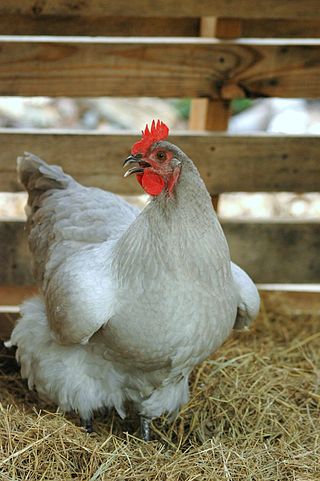
Lavender or self-blue refers to a plumage color pattern in the chicken characterized by a uniform, pale bluish grey color across all feathers. The distinctive color is caused by the action of an autosomal recessive gene, commonly designated as "lav", which reduces the expression of eumelanin and phaeomelanin so that black areas of the plumage appear pale grey instead, and red areas appear a pale buff.

The melanocortin 1 receptor (MC1R), also known as melanocyte-stimulating hormone receptor (MSHR), melanin-activating peptide receptor, or melanotropin receptor, is a G protein–coupled receptor that binds to a class of pituitary peptide hormones known as the melanocortins, which include adrenocorticotropic hormone (ACTH) and the different forms of melanocyte-stimulating hormone (MSH). It is coupled to Gαs and upregulates levels of cAMP by activating adenylyl cyclase in cells expressing this receptor. It is normally expressed in skin and melanocytes, and to a lesser degree in periaqueductal gray matter, astrocytes and leukocytes. In skin cancer, MC1R is highly expressed in melanomas but not carcinomas.

In poultry standards, solid white is coloration of plumage in chickens characterized by a uniform pure white color across all feathers, which is not generally associated with depigmentation in any other part of the body.

Agouti is a type of fur coloration in which each hair displays two or more bands of pigmentation. The overall appearance of agouti fur is usually gray or dull brown, although dull yellow is also possible.

Dogs have a wide range of coat colors, patterns, textures and lengths. Dog coat color is governed by how genes are passed from dogs to their puppies and how those genes are expressed in each dog. Dogs have about 19,000 genes in their genome but only a handful affect the physical variations in their coats. Most genes come in pairs, one being from the dog's mother and one being from its father. Genes of interest have more than one expression of an allele. Usually only one, or a small number of alleles exist for each gene. In any one gene locus a dog will either be homozygous where the gene is made of two identical alleles or heterozygous where the gene is made of two different alleles.
The agouti gene, the Agouti-signaling protein (ASIP) is responsible for variations in color in many species. Agouti works with extension to regulate the color of melanin which is produced in hairs. The agouti protein causes red to yellow pheomelanin to be produced, while the competing molecule α-MSH signals production of brown to black eumelanin. In wildtype mice, alternating cycles of agouti and α-MSH production cause agouti coloration. Each hair has bands of yellow which grew during agouti production, and black which grew during α-MSH production. Wildtype mice also have light-colored bellies. The hairs there are a creamy color the whole length because the agouti protein was produced the whole time the hairs were growing.